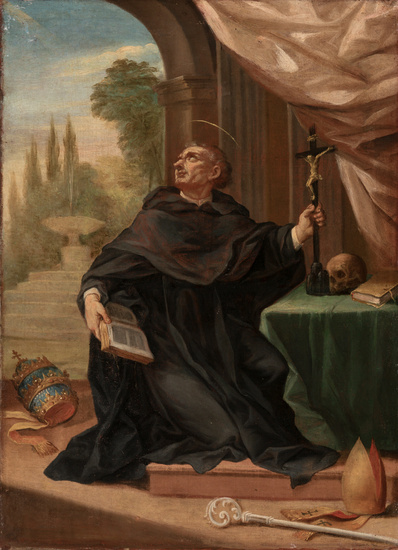Escuela napolitana; principios del siglo XVIII
Neapolitan school; early 18th century.
"Gaspar de Bono".
Oil on canvas. Relined.
It presents repainting.
Measurements: 94 x 69 cm.
The portrait follows in a certain way, models inherited from the baroque period as it can be appreciated in the representation of the big curtain placed in the upper right zone. The narrative scene shows the figure of a religious man holding a crucifix in his hands and a bible in the other. The figure, wearing a nimbus of sanctity, looks up at the sky, which coincides with a ray of light that comes from the landscape outside and crosses the room until it reaches the sitter. Despite his humble black clothing, we can discern that he is a high church official, as his mitre and bishop's crozier can be seen on the ground. The portrait is set against an idealised landscape background of the type usually found in works from the Italian school, thus softening the Baroque characteristics of the portrait. In the foreground, and with the aid of a tree, the composition is completed by the architecture in which the main figure is inscribed.
The hallmark of the Neapolitan school has always been its strong naturalistic character, its warm colour, with reddish and chestnut dominating, and the cultivation, together with the altarpiece, of a type of realist painting as its best exponent. In Naples, Ribera's influence was equal to or greater than that of Caravaggio. His naturalism, more sensual and material, more vigorous and vehement, less intellectual than Caravaggio's, eventually became permeable to Venetian and Flemish influences, becoming richer in colour and lighter in technique, especially from 1635 onwards. His most faithful disciples were the Fracanzano family, Cesare (1600-51) and Francesco (1612-56), Bartolomeo Bassante (1614-56), Paolo Domenico Finoglia (1590-1645) and some others who later cultivated special genres such as Aniello Falcone (1607-56), Salvatore Rosa (1615-73) and Luca Giordano. From the Baroque period onwards, however, the colours became softer and more nuanced, no longer opting for tenebrism, but retaining a great theatricality in the representations.
Presenta repintes.
View it on
Estimate
Time, Location
Auction House
Neapolitan school; early 18th century.
"Gaspar de Bono".
Oil on canvas. Relined.
It presents repainting.
Measurements: 94 x 69 cm.
The portrait follows in a certain way, models inherited from the baroque period as it can be appreciated in the representation of the big curtain placed in the upper right zone. The narrative scene shows the figure of a religious man holding a crucifix in his hands and a bible in the other. The figure, wearing a nimbus of sanctity, looks up at the sky, which coincides with a ray of light that comes from the landscape outside and crosses the room until it reaches the sitter. Despite his humble black clothing, we can discern that he is a high church official, as his mitre and bishop's crozier can be seen on the ground. The portrait is set against an idealised landscape background of the type usually found in works from the Italian school, thus softening the Baroque characteristics of the portrait. In the foreground, and with the aid of a tree, the composition is completed by the architecture in which the main figure is inscribed.
The hallmark of the Neapolitan school has always been its strong naturalistic character, its warm colour, with reddish and chestnut dominating, and the cultivation, together with the altarpiece, of a type of realist painting as its best exponent. In Naples, Ribera's influence was equal to or greater than that of Caravaggio. His naturalism, more sensual and material, more vigorous and vehement, less intellectual than Caravaggio's, eventually became permeable to Venetian and Flemish influences, becoming richer in colour and lighter in technique, especially from 1635 onwards. His most faithful disciples were the Fracanzano family, Cesare (1600-51) and Francesco (1612-56), Bartolomeo Bassante (1614-56), Paolo Domenico Finoglia (1590-1645) and some others who later cultivated special genres such as Aniello Falcone (1607-56), Salvatore Rosa (1615-73) and Luca Giordano. From the Baroque period onwards, however, the colours became softer and more nuanced, no longer opting for tenebrism, but retaining a great theatricality in the representations.
Presenta repintes.



